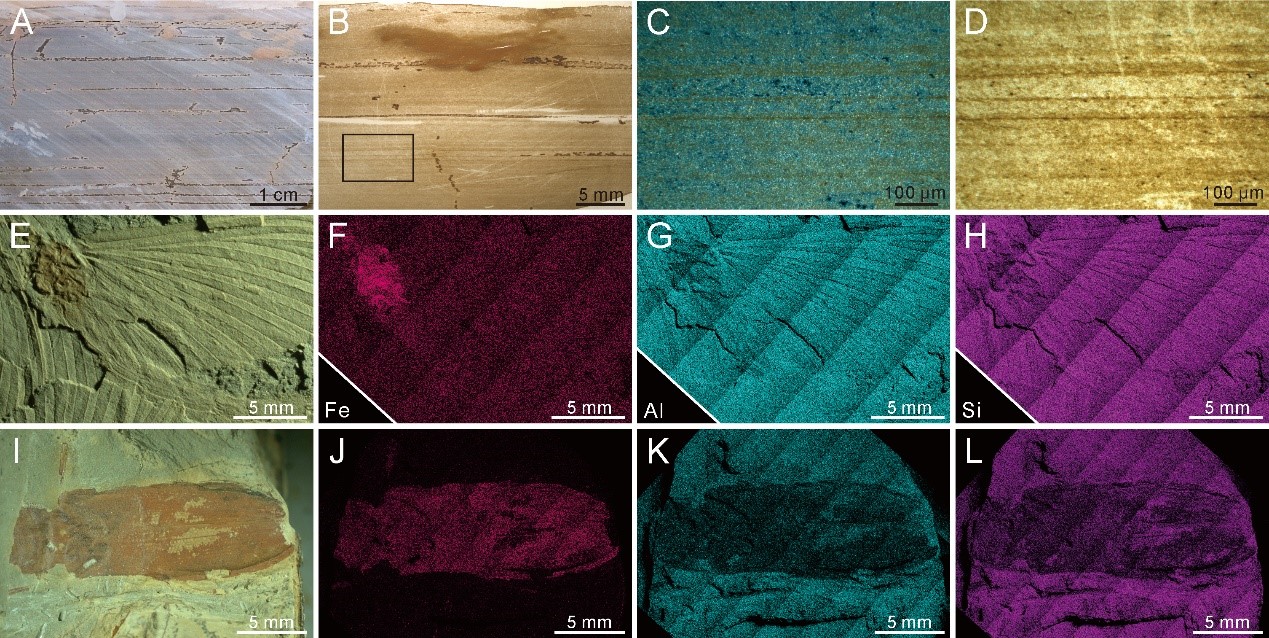Resource pulses, occasional events of ephemeral resource superabundance, represent a fundamental mechanism by which energy, nutrients, and biomass are transported across ecotones. They are widespread in extant ecosystems; however, little is known about their deep-time record.
Recently, ZHANG Qianqi, a PhD student from the Nanjing Institute of Geology and Palaeontology, Chinese Academy of Sciences (NIGPAS), under the supervision of Profs. WANG Bo and ZHANG Haichun, in collaboration with other researchers carried out a detailed investigation of early Mesozoic terrestrial strata in several regions in southern China. The researchers discovered abundant marine and terrestrial animal and plant fossils in the Lower Jurassic Shiti Formation in the Xiwan Basin of Hezhou City, Guangxi Province, China. Researchers report the earliest-known mayfly swarm from the Early Jurassic Xiwan biota of southern China, and the results were published in the journals Geology and Historical Biology.
The Mesozoic study in the Xiwan Basin has a long history, and both Profs. SZE Hsing-Chien and ZHOU Zhiyan had ever studied the plant fossils from Xiwan, among which plenty of insect fossils from the Shitian Formation were reported by Prof. LIN Qibin. "We recently found abundant new insects, plants, and shark egg capsules from a new fossil locality. In view of the abundance of the diverse insects and plants, we propose that the fossil assemblage in the lower unit of the Shiti Formation be named the Xiwan biota, which is among the richest Jurassic biotas in China", ZHANG Qianqi says.
This research team found one fossil layer with hundreds of mayflies in the lower unit of the Shiti Formation. These mayflies were classified as a new taxon, Jurassephemera zhangi Zhang et al. (2022), which is assigned to the extinct family Sharephemeridae, a stem group mayflies in terms of taxonomic position. This is the first discovery of the mayfly family in China, and is the best preserved fossil of the family.
"We measured the orientations of 381 mayflies and found that these mayflies do not show any obvious directionality, although the rose diagram suggests a south westerly trend perhaps reflecting the effect of a slight movement of the bottom water after accumulation of the carcasses", says ZHANG. Furthermore, all the mayflies are complete with body, appendages, and wings attached, which, when taken with the above, indicates that the mayflies were not transported any significant distance in the water after death and were buried in a low-energy preservational environment.
Extant mayflies spend most of their life in the aquatic environment as nymphs, and the adults commonly live from as little as 1–2 hours to a few days. During their short adult phase, the males form dense aggregations, and the females must find mating partners while flying in and through large swarms, wherein they copulate and ultimately locate a suitable place to deposit eggs. Mating-swarm behavior was previously known only in crown mayflies; however, our find reveals that such complex behaviors were already well established in stem-group mayflies by the Early Jurassic. "And this finding represents the earliest evidence of mating-swarm behavior in insects", ZHANG says.
Using elemental energy spectroscopy and Raman component analysis, the results show that the outermost layer of the fossils of the Xiwan biota is mainly iron oxides and clay mineral residues, but the surface composition of the fossils is still dominated by carbon elements. The researchers conclude that the iron oxide covering of the fossil surface was formed during the diagenetic process later and likely formed during the weathering process.
Aquatic insects play an important role in aquatic food webs, acting as consumers of aquatic plants and animals, and they are in turn consumed by fish and other predators. But aquatic insects can also be important parts of food webs on land when they emerge as adults from the water and fly to disperse and find mates. In addition to providing food bonanzas for predators, emerging insects can also have a fertilizing effect on plant communities next to lakes and streams when they die and decompose.
This study shows that some Jurassic mayflies emerged all at once in large swarms, which is a “pulse” of insects moving from the water to land, probably resulting in massive ecosystem fluxes in waterside habitats with impacts on basic ecology and biogeochemical cycling. Such a mechanism that can play a substantial role in nutrient transport from aquatic ecosystems to surrounding terrestrial ecosystems, while this aquatic-terrestrial ecosystem linkage may be a key novelty in Mesozoic lacustrine ecosystems. "Therefore, our finding highlights the underappreciated ecological significance of insects in short-lived feeding bonanzas and mass mortalities in deep-time lacustrine ecosystems." ZHANG added.
This research was supported by the Strategic Priority Research Program of the Chinese Academy of Sciences and the National Natural Science Foundation of China.
Reference: Zhang Qianqi, Wang Bo*, Zheng Daran, Li Jiahao, Wang Xueheng, Jarzembowski E.A., Xu Chunpeng, Li Ting, Zhang Haichun, Engel M.S. 2022. Mayflies as resource pulses in Jurassic lacustrine ecosystems. Geology. https://doi.org/10.1130/G50055.1.
Zhang Qianqi*, Zheng Daran, Jarzembowski E.A., Wang Xueheng, Li Jiahao, Engel M.S. 2022. The first Sharephemeridae (Insecta: Ephemeroptera) from the Jurassic Shiti Formation of South China. Historical Biology. https://doi.org/10.1080/08912963.2022.2077649.

Figure 1: Three pieces of fossil surface with mayfly swarms from the Shiti Formation in southern China. All are the same scale and orientation.

Figure 2: Sedimentology (A–D) and taphonomy (E–L) of the fossil-bearing layer from the Shiti Formation in southern China.

Figure 3: Reconstruction of the Early Jurassic ecosystem of the Xiwan Basin (designed by YANG Dinghua, NIGPAS).
Contact:
LIU Yun, Propagandist
Email: yunliu@nigpas.ac.cn
Nanjing Institute of Geology and Palaeontology, Chinese Academy of Sciences
Nanjing, Jiangsu 210008, China
